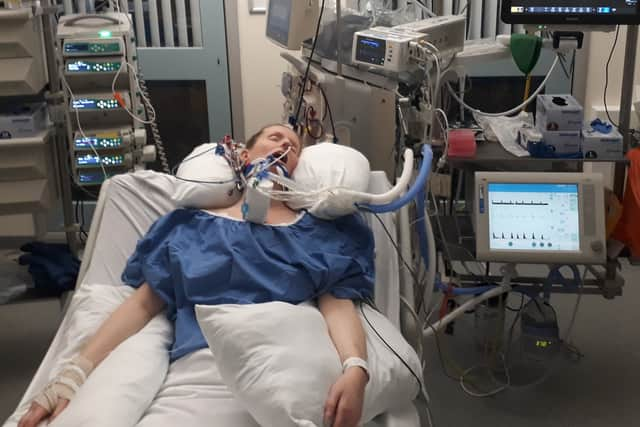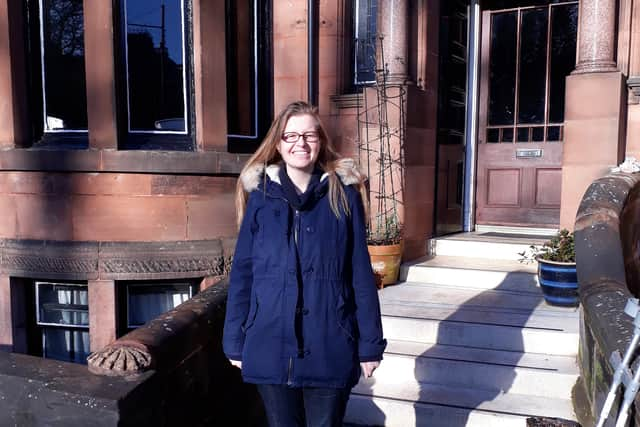Woman, 45, who thought sepsis was a cold ended up in intensive care and was forced to learn how to walk again
and live on Freeview channel 276
A woman who mistook sepsis for a ‘bad cold’ has revealed she ended up in intensive care and was forced to learn how to walk again. Suzanne Graham, 45, was struggling to breathe and talk, suspecting it was just a cold, in the run-up to Christmas.
Suzanne then made an appointment with her GP as her symptoms rapidly worsened. She was then taken to intensive care and attached to a ventilator.
Advertisement
Hide AdAdvertisement
Hide AdThe 45-year-old from Glasgow had severe pneumonia and 10-20% of lung function, acute respiratory distress syndrome, and sepsis.
Suzanne was in intensive care for ten days - so long her muscles wasted away - and she was unable to sit in bed.She couldn’t stand and had to learn to walk again with the help of three physiotherapists.
After extensive work during the week with physiotherapists to learn to adjust to using crutches, Suzanne was finally able to return home following the ordeal in 2019.


Speaking about when she first fell ill, she said: ‘’I was busy and there was a lot happening.
Advertisement
Hide AdAdvertisement
Hide Ad“I had a cold that I didn’t think too much about, but it just lingered. When it got closer to Christmas, I started to get more unwell, but I thought that the cold had just developed into a flu.
“Looking back, I had no idea how unwell I really was. I’d been unwell for a number of days, and I couldn’t sleep. I was really struggling to breathe. One night, I couldn’t sleep, and I remembered that my friend, who was the same age as me, had had pneumonia.
“I thought that was unusual, because I’d always associated pneumonia with older people, so I looked up the symptoms of pneumonia and the flu, and quickly found that my symptoms were all pointing towards pneumonia.”
Suzanne added her husband had to help her get to the GP, which is around 50 metres away from her home, as she was unable to walk. Speaking about the experience at the doctors, she said: “The GP measured my blood oxygen and listened to my lungs. I just remember her saying to me, ‘I don’t want to alarm you, but we will be calling an ambulance – you have to go to hospital’.
Advertisement
Hide AdAdvertisement
Hide Ad“The ambulance came and took me to intensive care. I remember getting into the ambulance, but I have no memories from then on, so this is all from what I’ve been told by family members.”
Upon arriving at intensive care, Suzanne was attached to a ventilator – but again, the situation worsened. She continued: “I was in need of oxygen. It took a little bit of time to attach the ventilator, and then they came back and spoke to my husband.
“They said that the situation had spiralled out of control, and the oxygen that I was getting from the ventilator wasn’t going to be enough to keep me alive. The only treatment option that was available was ECMO treatment. It is specifically coordinated in Leicester and there’s a specific protocol you have to follow to access the treatment.
‘’They had to see if I was suitable for it too, because not everybody is – and they only deliver it in a few places across the UK.”
Advertisement
Hide AdAdvertisement
Hide AdECMO, or Extra Corporeal Membrane Oxygenation, is a treatment used in extreme cases where a patient’s lungs or heart are not functioning at a normal level. The machine uses an artificial lung to oxygenate the blood outside of the body.
Luckily, Suzanne was eligible for the treatment – but the closest machine was 145 miles away in Aberdeen. A team of five medical staff drove through the night with a portable ECMO machine, which Suzanne was immediately hooked up to on arrival.
She said: “Normally, they would hook you up to an ECMO machine in a theatre, but I was so unwell that they couldn’t move me at all. Then they took me and drove me through the night to Aberdeen in an ambulance.
“Essentially, the pneumonia had become severe. I had 10-20% of lung function, acute respiratory distress syndrome, and sepsis. It was getting into a multi-organ failure type situation – my lungs and kidneys were failing.”
Advertisement
Hide AdAdvertisement
Hide AdSuzanne was in Aberdeen for seven days, where she continued to receive ECMO treatment. Luckily, she responded well, and was able to be transferred back to Glasgow to continue her treatment.
She was still in intensive care, but no longer needed a ventilator to breathe, and doctors were able to take Suzanne out of the heavily medicated state she had been in throughout her ordeal.
“This is when I start to have memories of being there,” she said.
“ I was massively confused about what had happened, because of a mix of what my body went through, and the drugs that I was given. I had quite severe hallucinations. I didn’t know they were hallucinations at the time – I thought everything was just very strange.”
Advertisement
Hide AdAdvertisement
Hide AdFully conscious, Suzanne was then moved to a high dependency unit for the next week, where her recovery began.
She added: “I was bedbound. I was in hospital for three weeks, and it’s amazing just how quickly you lose your muscle mass. I think they call it ‘intensive care syndrome’ – because you’re just lying there, you lose your muscles. My muscles had just wasted away in that time.’’
Unable to sit up in bed, never mind stand, three physiotherapists had to help her stand for the first time, as she was no longer able to support her own body weight.
After extensive work during the week with physiotherapists to learn to adjust to using crutches, Suzanne was finally able to return home. Hospital staff told her that recovery could take a year, based on the severity of her illness and the time spent in intensive care, so Suzanne began to process her experience.
Advertisement
Hide AdAdvertisement
Hide Ad

“Mentally, it’s been a lot. It’s a known thing for people in intensive care to experience hallucinations – people can struggle with making sense of that,” said Suzanne.
“Mine were so real, and I was convinced they were. It took me a while to accept that they weren’t. That throws a lot of things into confusion – was this memory real, was it another hallucination?
“My brain also felt really slow and I was worried about returning to work. What if I couldn’t remember how to do my job? Physically, the main recovery was centered around building up my fitness. I’d lost a lot of weight and muscle mass, so I was building up fitness.
“I’m so grateful to the doctors and hospital staff, they were amazing. My family were there by my side the whole time and supported me through. I’ve been extremely lucky to survive it intact – sepsis can cause loss of limbs and have other physical effects. I’m very lucky to have made a complete recovery.”
Advertisement
Hide AdAdvertisement
Hide AdNow five years on, and fully recovered, Suzanne has become passionate about sharing her story to raise awareness of the symptoms and dangers of sepsis – a medical emergency which kills around 50,000 people per year in the UK.
According to charity Sepsis Research FEAT, symptoms to look out for include very high or low temperature, confusion, shaking, blotchy skin and a difficulty urinating - combinations of these symptoms or rapidly worsening symptoms, are a reason to seek urgent medical attention.
Comment Guidelines
National World encourages reader discussion on our stories. User feedback, insights and back-and-forth exchanges add a rich layer of context to reporting. Please review our Community Guidelines before commenting.
